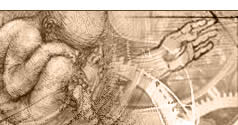 |
 |
 |
 |
 |
 |
 |
 |
|
 |
 |
 |
43 Uranium, helium and lead in zirconium
|
| Menu | back |
Zirconium crystals are found in granite around the world. Some of these crystals also contain small quantities of uranium, which is subject to radioactive decay producing helium and lead, both stable substances. It is possible to calculate the age of the crystals based on the quantity of helium present today and the rate at which it continuously escapes, commonly called its diffusion rate. Interestingly enough, rock strata that are allegedly billions of years old, occasionally contain zirconium that is only 4,000 to 8,000 years old on the basis of helium content.
|
The uranium frequently contained in zirconium crystals is an unstable element, which decays to form lead and helium in the course of time. While the small helium atoms slowly escape from the crystal after decay, the larger uranium and lead atoms remain trapped in the crystal. The more uranium decays to form lead and helium, the older the crystal must be. It is possible to draw conclusions regarding the age of the crystal by comparing the ratio of uranium atoms to lead atoms. This quite frequently results in age figures of over one billion years.
Helium diffusion rate:
However, if the quantity of helium still present in the crystal is taken into consideration, an age of 4,000 to 8,000 years (1) can be calculated, considering the quantity of helium escaping from the crystal per time unit (helium diffusion rate).
If the uranium had decayed at the same rate as today in the course of a billion years, the helium would have been able to escape from the crystal continuously over this long period and we would hardly find any helium still present in the crystal today (2). The quantity of the helium content is therefore an indicator that the crystals were occasionally subjected to strong radiation leading to accelerated decay (3).
Legitimate criticism:
Unfortunately, to date it has only been possible to use specimens from one single deep well, making the worldwide significance of these results dubious. Moreover, the location selected for the well was in the vicinity of natural helium deposits which could have lead to contamination. In any case, it would be desirable for public universities to examine this subject.
These 44 | Menu |
back
|
References:
|
| (1) |
Larry Vardiman, Andrew A. Snelling, Eugene F. Chaffin, Radioisotopes and the age of the Earth, Vol. 2, Institute for Creation Research, El Cajon, CA, 2005, page 56. |
| (2) |
ICR Acts & Facts, Vol. 31. No. 10 October, 2002. |
| (3) |
Don DeYoung, Thousands
not Billions, Challenging an Icon of Evolution, Master Books, 2005. | |
| |
Comment this Site!
|
 |
 |
 |
 |
|

